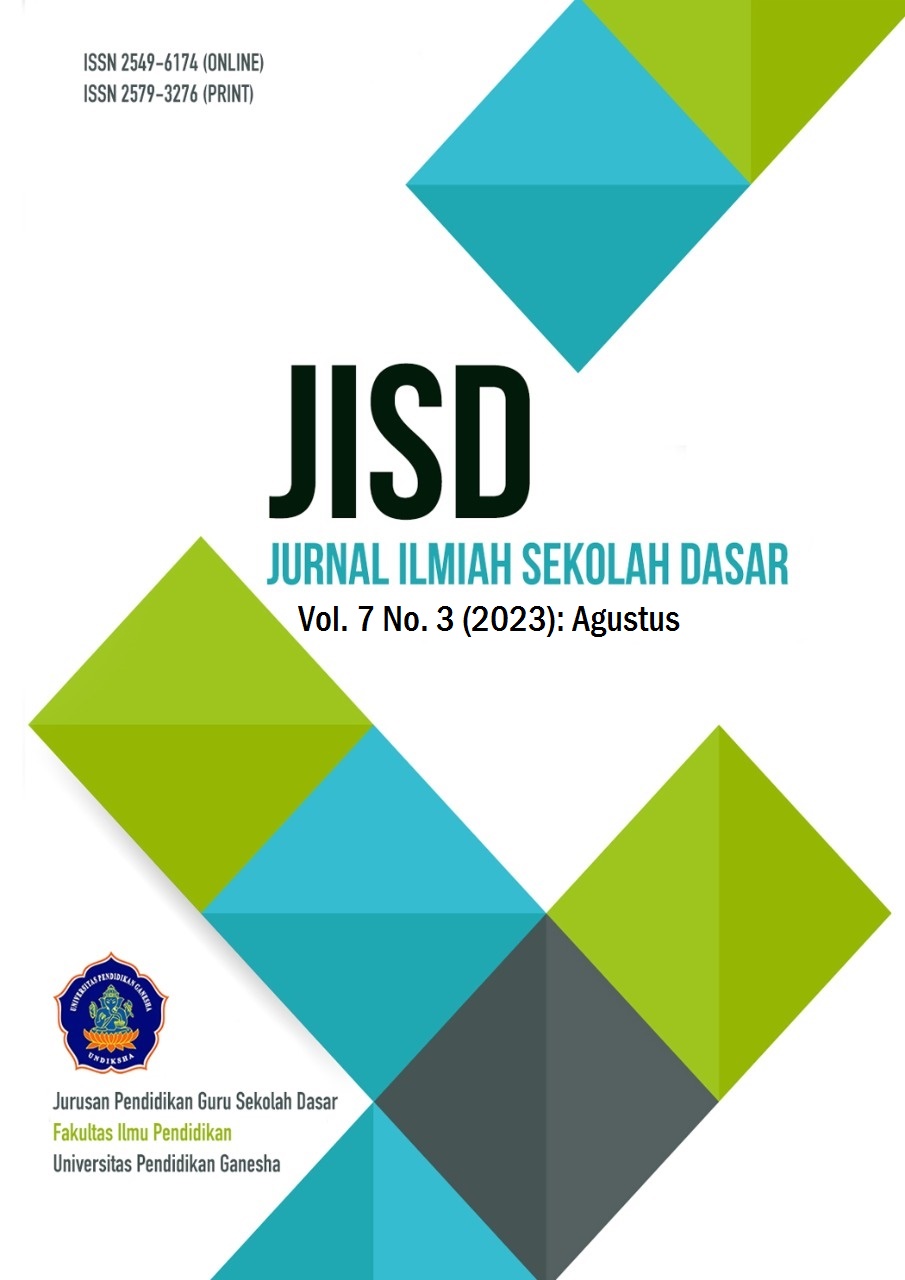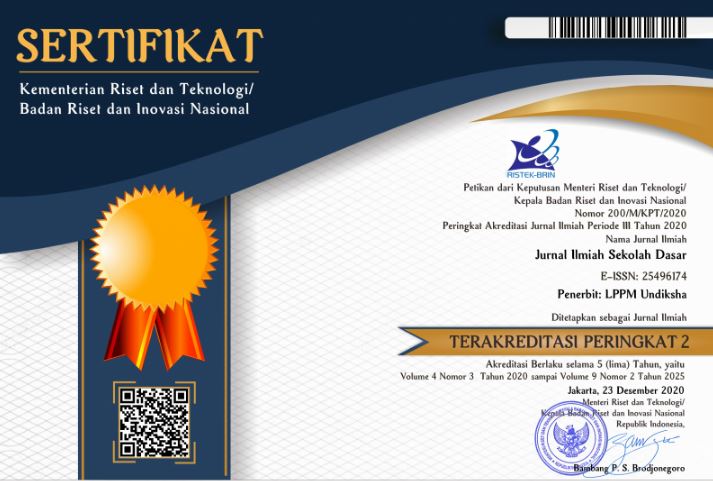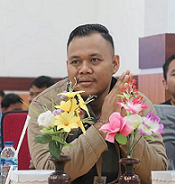The Right Method for Developing Elementary School Student’s Creative Thinking Skills
DOI:
https://doi.org/10.23887/jisd.v7i3.58273Keywords:
Learning Methods, Mind Mapping Methods, Picture And Picture Methods, Creative ThinkingAbstract
Thinking creatively is very important for students in the 21st century because the demands of the times expect creative students to discover new things with advances in science and technology. The learning method applied at this time has yet to be able to train students to think creatively. This study aims to analyze differences in students' creative thinking skills between the mind mapping method and the picture and picture method. The research method used was quasi-experimental with a posttest-only control group design. The sample used was 45 fifth-grade elementary school students. The data collection technique uses a creative thinking ability test, which consists of four indicators: the ability to think fluently, flexibly, originality, and elaboration. Data analysis used a t-test through Jeffreys's Amazing Statistics software program. The results of the data analysis showed that Cohen's d score was 0.830. These results indicate a significant difference between the two learning methods. Based on the average score and the percentage of scores obtained by students on each indicator of creative thinking, it shows that mind mapping is superior to the picture-and-picture method in developing creative thinking. It was concluded that elementary school teachers can apply the mind mapping method to develop students' creative thinking skills.
References
Acesta, A. (2020). Pengaruh Penerapan Metode Mind Mapping Terhadap Kemampuan Berpikir Kreatif Siswa. NATURALISTIC : Jurnal Kajian Penelitian Pendidikan Dan Pembelajaran, 4(2b), 581–586. https://doi.org/10.35568/naturalistic.v4i2b.766. DOI: https://doi.org/10.35568/naturalistic.v4i2b.766
Aditya, F. A., Dian, K., Afiani, A., Faradita, M. N., Surabaya, U. M., Surabaya, U. M., Surabaya, U. M., & Picture, M. (2022). Peningkatan hasil belajar dengan metode Picture and picture pada materi pecahan kelas II SD Muhammadiyah 9 Surabaya masa pandemi covid-19. Autentik: Jurnal Pengembangan Pendidikan Dasar, 6(1), 123–137. https://doi.org/10.36379/autentik.v6i1.185. DOI: https://doi.org/10.36379/autentik.v6i1.185
Alderbashi, K. Y., & Moussa, M. K. (2022). Effectiveness of Employing the E-mind Mapping Strategy in Scientific Courses: Adopting the Blended Learning Approach at Emirati Private Preparatory Schools. Journal of Curriculum and Teaching, 11(4), 159–170. https://doi.org/10.5430/jct.v11n4p159. DOI: https://doi.org/10.5430/jct.v11n4p159
Ananda, R. (2019). Penerapan Metode Mind Mapping Untuk Meningkatkan Kemampuan Berpikir Kreatif Siswa Sekolah Dasar. Edukatif : Jurnal Ilmu Pendidikan, 1(1), 1–10. https://doi.org/10.31004/edukatif.v1i1.1. DOI: https://doi.org/10.31004/edukatif.v1i1.1
Buchari, A. (2018). Peran Guru Dalam Pengelolaan Pembelajaran. Jurnal Ilmiah Iqra’, 12(2), 106. https://doi.org/10.30984/jii.v12i2.897. DOI: https://doi.org/10.30984/jii.v12i2.897
Chen, S.-Y. (2022). To explore the impact of augmented reality digital picture books in environmental education courses on environmental attitudes and environmental behaviors of children from different cultures. In Frontiers in Psychology (Vol. 13). https://doi.org/10.3389/fpsyg.2022.1063659. DOI: https://doi.org/10.3389/fpsyg.2022.1063659
Chen, S. Y., Lai, C. F., Lai, Y. H., & Su, Y. S. (2019). Effect of project-based learning on development of students’ creative thinking. International Journal of Electrical Engineering Education. https://doi.org/10.1177/0020720919846808. DOI: https://doi.org/10.1177/0020720919846808
Damayanti, N., Victoria, D. C., & Rohartati, S. (2019). Pengaruh Model Pembelajaran Kooperatif Tipe Picture And Picture Terhadap Peningkatan Kemampuan Berpikir Kritis Peserta Didik Pada Mata Pelajaran Ilmu Pengetahuan Alam di Sekolah Dasar. Primaria Educationem Journal (PEJ), 2(1), 29–43. https://core.ac.uk/download/pdf/322531072.pdf. DOI: https://doi.org/10.47453/edubase.v1i1.41
Davies, M. (2011). Concept mapping, mind mapping and argument mapping: what are the differences and do they matter? Higher Education 2010 62:3, 62(3), 279–301. https://doi.org/10.1007/S10734-010-9387-6. DOI: https://doi.org/10.1007/s10734-010-9387-6
Evangelisa, E., Sri Asri, I. G. A. A., & Sujana, I. W. (2020). Pengaruh Model Pembelajaran Process Oriented Guided Inquiry Learning Berbantuan Media Mind Mapping Terhadap Kompetensi Pengetahuan IPA. Jurnal Penelitian Dan Pengembangan Pendidikan, 4(2), 270. https://doi.org/10.23887/jppp.v4i2.27384. DOI: https://doi.org/10.23887/jppp.v4i2.27384
Febriyanti, N. W. E., Rati, N. W., Murda, N., & Pgsd, J. (2017). Pengaruh Model Pembelajaran Picture and Picture Terhadap Hasil Belajar Ipa Siswa Kelas V Sd. Journal PGSD Universitas Pendidikan Ganesha Mimbar PGSD, 5(2), 1. https://doi.org/10.31004/obsesi.v6i4.1970. DOI: https://doi.org/10.31004/obsesi.v6i4.1970
Febriyanti, S. A., & Wulandari, F. (2021). Hubungan Berpikir Kreatif Melalui Model Mind Mapping dengan Hasil Belajar Siswa Sekolah Dasar. Pedagogika, 12(2), 152–160. https://doi.org/10.37411/pedagogika.v12i2.871. DOI: https://doi.org/10.37411/pedagogika.v12i2.871
Fox, W., & Bayat, M. S. (2007). A Guide to Managing Research. Juta Publications.
Gultom, E., & Saun, S. (2016). The role of classroom management in creating an effective english learning. Journal of English Language Teaching, 5(1), 18–24. https://doi.org/10.24036/jelt.v5i1.7261.
Hidayat, H., Mulyani, H., Fatimah, A. S., Sholihat, A., & Latifah, A. Z. (2020). Penerapan Metode Mind Mapping Untuk Meningkatkan Kreativitas Pada Pembelajaran Pendidikan Kewarganegaraan. Jurnal Pendidikan, 21(1), 38–50. https://doi.org/10.33830/jp.v21i1.546.2020. DOI: https://doi.org/10.33830/jp.v21i1.546.2020
Juwantara, R. A. (2019). Analisis Teori Perkembangan Kognitif Piaget Pada Tahap Anak Usia Operasional Konkret 7-12 Tahun Dalam Pembelajaran Matematika. Al-Adzka: Jurnal Ilmiah Pendidikan Guru Madrasah Ibtidaiyah, 9(1), 27–34. https://core.ac.uk/download/pdf/327227393.pdf. DOI: https://doi.org/10.18592/aladzkapgmi.v9i1.3011
Lokat, Y. T., Bano, V. O., & Enda, R. R. H. (2022). Pengaruh Model Pembelajaran Kooperatif Tipe Picture and Picture Terhadap Hasil Belajar Siswa. Binomial, 5(2), 126–135. https://doi.org/10.46918/bn.v5i2.1450. DOI: https://doi.org/10.46918/bn.v5i2.1450
Madadizadeh, F. (2022). A tutorial on Quasi-experimental designs. Journal of Community Health Research, 11(1), 3–4. https://doi.org/10.18502/jchr.v11i1.9089. DOI: https://doi.org/10.18502/jchr.v11i1.9089
Marlina, L. (2020). Kajian Pengaruh Penggunaan Model Pembelajaran Picture And Picture Terhadap Prestasi Belajar IPA Siswa Sekolah Dasar. Ainara Journal (Jurnal Penelitian Dan PKM Bidang Ilmu Pendidikan), 1(2), 56–61. https://doi.org/10.54371/ainj.v1i2.14. DOI: https://doi.org/10.54371/ainj.v1i2.14
Mulyasari, Putu Arga, A. (2022). Pembelajaran pemahaman ipa siswa kelas iv sekolah dasar melalui model picture and picture. Elementary Education Volume, 05(01), 180–187. https://doi.org/10.22460/collase.v5i1.5681.
Muskitta, M., & Djukri, D. (2016). Pengaruh model PBT terhadap kemampuan berpikir kritis dan kemampuan berpikir kreatif siswa SMAN 2 Magelang. Jurnal Inovasi Pendidikan IPA, 2(1), 58. https://doi.org/10.21831/jipi.v2i1.8809. DOI: https://doi.org/10.21831/jipi.v2i1.8809
Nizaar, M., Sukirno, Djukri, & Haifaturrahmah. (2020). Wastepreneurship: A model in improving students’ confidence and creativity. European Journal of Educational Research, 9(4), 1473–1482. https://doi.org/10.12973/eu-jer.9.4.1473. DOI: https://doi.org/10.12973/eu-jer.9.4.1473
Prasetya, R. E. (2021). Effectiveness of Teaching English for Specific Purposes in LMS Moodle: Lecturers’ Perspective. Journal of English Language Teaching and Linguistics, 6(1), 93. https://doi.org/10.21462/jeltl.v6i1.498. DOI: https://doi.org/10.21462/jeltl.v6i1.498
Pratiwi, N., & Aslam, A. (2021). Pengaruh Model Pembelajaran Picture And Picture terhadap Kemampuan Berpikir Kreatif Siswa di Sekolah Dasar. Edukatif : Jurnal Ilmu Pendidikan, 3(6), 3697–3703. https://doi.org/10.31004/edukatif.v3i6.1081. DOI: https://doi.org/10.31004/edukatif.v3i6.1081
Putra, I. K. R., Rati, N. W., & Murda, I. N. (2019). Pengaruh Model Pembelajaran Quantum Learning Berbantuan Peta Pikiran Terhadap Kemampuan Berpikir Kreatif Dan Hasil Belajar IPS Siswa Kelas V. Jurnal Pendidikan IPS Indonesia, 3(1), 42–52. https://doi.org/10.23887/pips.v3i1.2875. DOI: https://doi.org/10.23887/pips.v3i1.2875
Savitri, E., Saadi, P., & Leny, L. (2019). Model Pembelajaran Core Berbantuan Mind Mapping Dalam Meningkatkan Kemampuan Berpikir Kreatif Peserta Didik Pada Materi Stoikiometri. Quantum: Jurnal Inovasi Pendidikan Sains, 10(1), 68. https://doi.org/10.20527/quantum.v10i1.5944. DOI: https://doi.org/10.20527/quantum.v10i1.5944
Schut, A., van Mechelen, M., Klapwijk, R. M., Gielen, M., & de Vries, M. J. (2022). Towards constructive design feedback dialogues: guiding peer and client feedback to stimulate children’s creative thinking. International Journal of Technology and Design Education, 32(1), 99–127. https://doi.org/10.1007/s10798-020-09612-y. DOI: https://doi.org/10.1007/s10798-020-09612-y
Septian, R. A. N., Safrina, R., Khaerudin, K., & Iasha, V. (2020). Rancangan Pelaksanaan Pembelajaran Dengan Metode Mind Mapping Untuk Meningkatkan Kemampuan Berpikir Kreatif. Jurnal Basicedu, 4(4), 1098–1103. https://doi.org/10.31004/basicedu.v4i4.485. DOI: https://doi.org/10.31004/basicedu.v4i4.485
Serevina, V., & Heluth, L. (2022). Development of Student’s Worksheets using Learning Strategies to Improve Thinking Ability Equipped with Mind Mapping and Ability of Student’s Retention. Journal of Physics: Conference Series, 2377(1). https://doi.org/10.1088/1742-6596/2377/1/012062. DOI: https://doi.org/10.1088/1742-6596/2377/1/012062
Seyihoglu, A., & Kartal, A. (2010). The Views of the Teachers about the mind mapping technique in the Elementary Life Science and Social Studies lessons Based on the Constructivist Method. Educational Sciences: Theory & Practice, 10(3), 1637–1656. https://eric.ed.gov/?id=EJ919863.
Su, Y. S., Shao, M., & Zhao, L. (2022). Effect of Mind Mapping on Creative Thinking of Children in Scratch Visual Programming Education. Journal of Educational Computing Research, 60(4), 906–929. https://doi.org/10.1177/07356331211053383. DOI: https://doi.org/10.1177/07356331211053383
Sumarta, I. G. B. (2017). Pengaruh Pembelajaran Berbasis Masalah Berbantuan Mind Map Terhadap Keterampilan Berpikir Kreatif dan Hasil Belajar Biologi Pada Siswa SMK. Jurnal Ilmiah Pendidikan Dan Pembelajaran, 1(1), 68–77. https://doi.org/10.23887/jipp.v1i1.11963.
Susdiana, B. E. (2017). Menulis Teks Eksplanasi Menggunakan Metode Picture And Picture Pada Siswa Kelas VII SMP. CENDEKIA: Journal of Education and Teaching, 11(1), 1. https://doi.org/10.30957/cendekia.v11i1.247. DOI: https://doi.org/10.30957/cendekia.v11i1.247
Syahidah, N. (2015). Metode pembelajaran mind mapping sebagai upaya mengembangkan kreativitas siswa dalam pembelajaran ekonomi. Prosiding Seminar Nasional, 108–117. https://core.ac.uk/download/pdf/33518646.pdf.
Ulandari, N., Putri, R., Ningsih, F., & Putra, A. (2019). Efektivitas Model Pembelajaran Inquiry terhadap Kemampuan Berpikir Kreatif Siswa pada Materi Teorema Pythagoras. Jurnal Cendekia : Jurnal Pendidikan Matematika, 3(2), 227–237. https://doi.org/10.31004/cendekia.v3i2.99. DOI: https://doi.org/10.31004/cendekia.v3i2.99
Usman, U., Utari, E., & Yulita, N. (2020). Hubungan Berpikir Kritis Dengan Kreativitas Siswa Melalui Mind Map Pada Pembelajaran Biologi. Bio-Lectura: Jurnal Pendidikan Biologi, 7(2), 143–152. https://doi.org/10.31849/bl.v7i2.5299. DOI: https://doi.org/10.31849/bl.v7i2.5299
Vorona, S., Lubov, D., B., & Olga, L. (2020). “Visualization of Learning and Memorizing Processes Using Mobile Devices: Mind Mapping and Charting.” International Journal of Interactive Mobile Technologies, 14(21), 136–52. https://doi.org/10.3991/ijim.v14i21.18475. DOI: https://doi.org/10.3991/ijim.v14i21.18475
Wannapiroon, N., & Pimdee, P. (2022). Thai undergraduate science, technology, engineering, arts, and math (STEAM) creative thinking and innovation skill development: a conceptual model using a digital virtual classroom learning environment. Education and Information Technologies, 27(4), 5689–5716. https://doi.org/10.1007/s10639-021-10849-w. DOI: https://doi.org/10.1007/s10639-021-10849-w
Wulandari, F. A., Mawardi, M., & Wardani, K. W. (2019). Peningkatan Keterampilan Berpikir Kreatif Siswa Kelas 5 Menggunakan Model Mind Mapping. Jurnal Ilmiah Sekolah Dasar, 3(1), 10. https://doi.org/10.23887/jisd.v3i1.17174. DOI: https://doi.org/10.23887/jisd.v3i1.17174
Z. Sh. Abdunazarova, A. G. G. (2021). Biophysics Of Brain Activity. Brain Activity In The Development Of “Creative Thinking” “Mind Map.” Turkish Journal of Computer and Mathematics Education (TURCOMAT), 12(4), 1–6. https://doi.org/10.17762/turcomat.v12i4.452. DOI: https://doi.org/10.17762/turcomat.v12i4.452
Downloads
Published
How to Cite
Issue
Section
License
Copyright (c) 2023 Ardilan Sari, Muhammad Nizaar, Haifaturrahmah, Najamudin, Emese K Nagy

This work is licensed under a Creative Commons Attribution-ShareAlike 4.0 International License.
Authors who publish with the Journal Ilmiah Sekolah Dasar agree to the following terms:
- Authors retain copyright and grant the journal the right of first publication with the work simultaneously licensed under a Creative Commons Attribution License (CC BY-SA 4.0) that allows others to share the work with an acknowledgment of the work's authorship and initial publication in this journal.
- Authors are able to enter into separate, additional contractual arrangements for the non-exclusive distribution of the journal's published version of the work (e.g., post it to an institutional repository or publish it in a book), with an acknowledgment of its initial publication in this journal.
- Authors are permitted and encouraged to post their work online (e.g., in institutional repositories or on their website) prior to and during the submission process, as it can lead to productive exchanges, as well as earlier and greater citation of published work. (See The Effect of Open Access)










